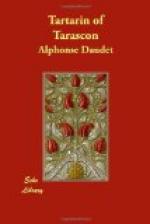Here is the grain berth. Stevedores empty the sacks onto the quay from a scaffold, the grain pours down in a golden torrent raising a cloud of pale dust, and is loaded by men wearing red fezes into carts, which set off followed by a regiment of women and children with brushes and buckets for gleaning.
There is the careening basin. The huge vessels lie over on one side and are flamed with fires of brushwood to rid them of seaweed, while their yardarms soak in the water. There is a smell of pitch and the deafening hammering of shipwrights lining the hulls with sheets of copper.
Sometimes, between the masts, a gap opened and Tartarin could see the harbour mouth and the movement of ships. An English frigate leaving for Malta, spruce and scrubbed, with officers in yellow gloves, or a big Marseilles brig, casting off amid shouting and cursing, with, in the bows, a fat captain in an overcoat and a top hat, supervising the manoeuvre in broad provencal. There were ships outward bound, running before the wind with all sails set, there were others, far out at sea, beating their way in and seeming in the sunshine to be floating on air.
Then, all the time the most fearsome racket. The rumbling of cart wheels, the cries of the sailors, oaths, songs, the sirens of steam-boats, the drums and bugles of Fort St. Jean and Fort St. Nicolas, the bells of nearby churches and, up above, the mistral, which took all of these sounds, rolled them together, shook them up and mingled them with its own voice to make mad, wild, heroic music, like a great fanfare, urging one to set sail for distant lands, to spread one’s wings and go. It was to the sound of this fine fanfare that Tartarin embarked for the country of lions.
Chapter 12.
I wish that I was a painter, a really good painter, so that I could present to you a picture of the different positions adopted by Tartarin’s chechia during the three days of the passage from France to Algeria.
I would show it to you first at the departure, proud and stately as it was then, crowning that noble Tarascon head. I would show it next when, having left the harbour, the Zouave began to lift on the swell. I would show it fluttering and astonished, as if feeling the first premonitions of distress.
Then, in the gulf of Lion, when the Zouave was further offshore and the sea a little rougher, I would present it at grips with the storm, clutching, bewildered, at the head of our hero, its long blue woollen tassel streaming in the spume and gusting wind.
The fourth position. Six in the evening. Off the coast of Corsica. The wretched chechia is leaning over the rail and sadly contemplating the depths of the ocean.
Fifth and last position. Down in a narrow cabin, in a little bed which has the appearance of a drawer in a commode, something formless and desolate rolls about, moaning, on the pillow. It is the chechia, the heroic chechia, now reduced to the vulgar status of a night-cap, and jammed down to the ears of a pallid and convulsing invalid.




